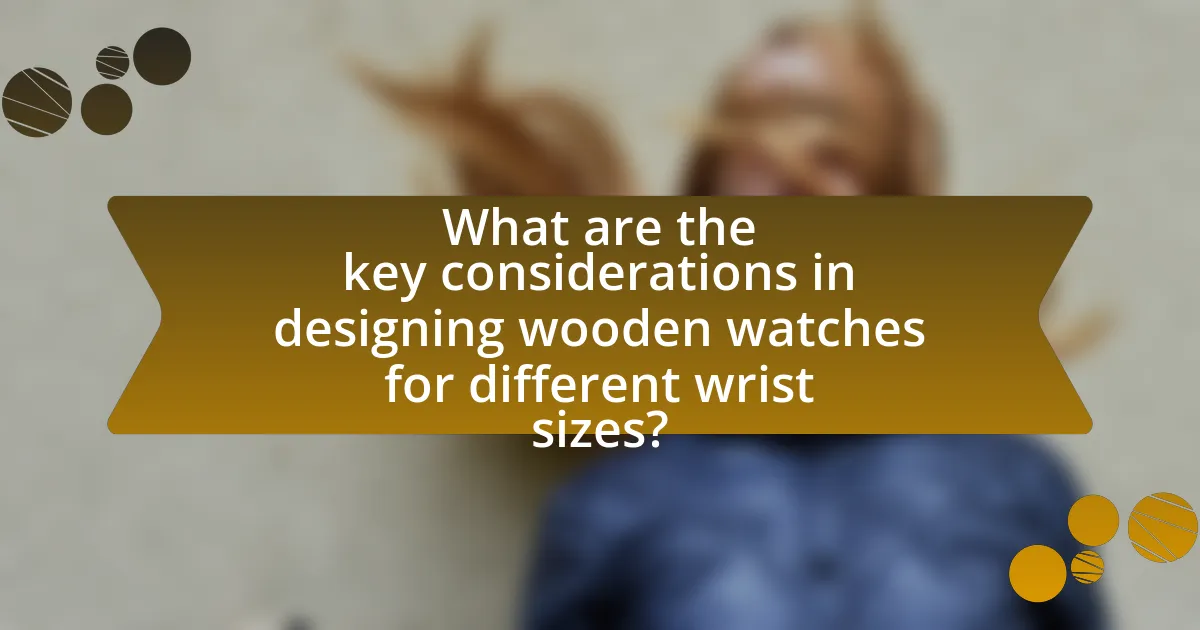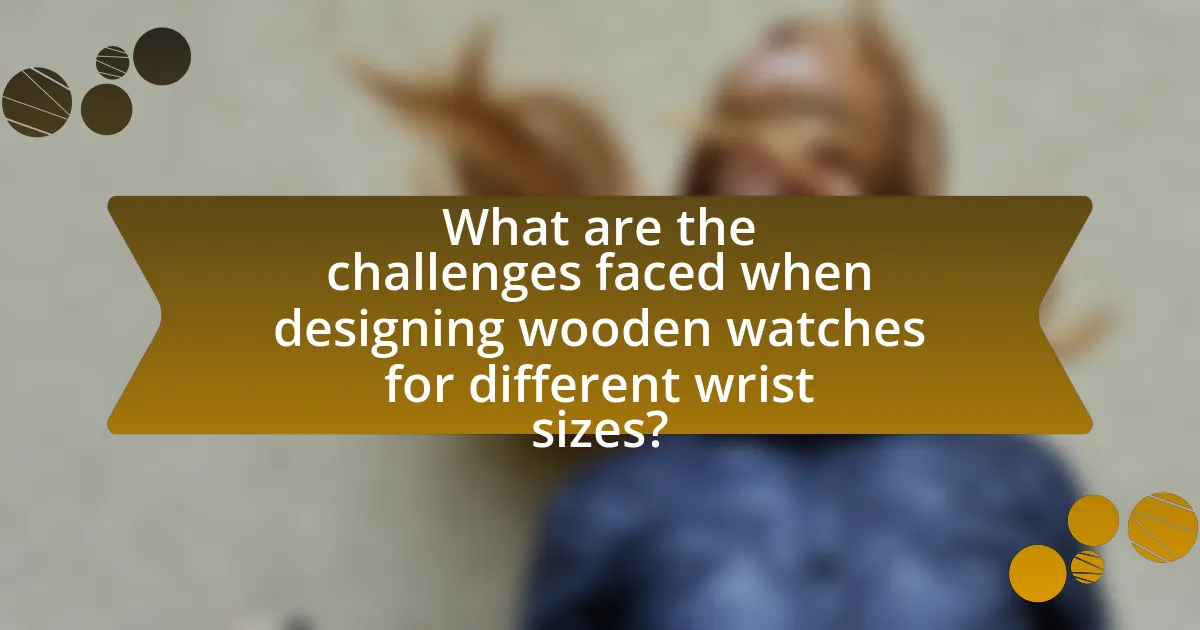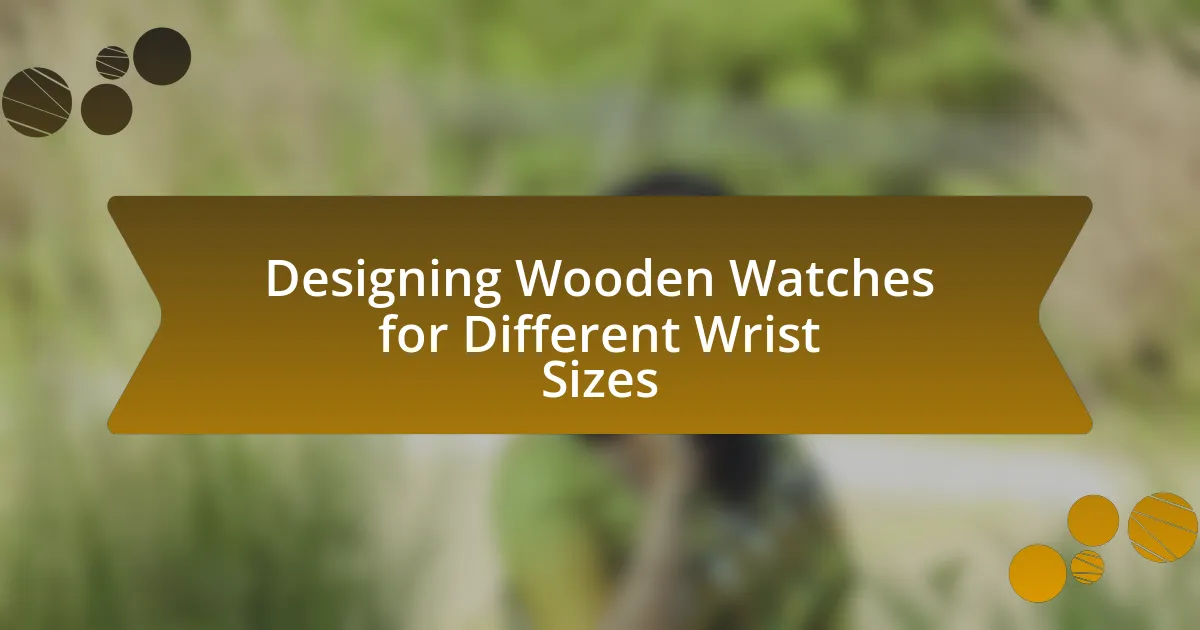The article focuses on the design of wooden watches tailored for different wrist sizes, emphasizing key considerations such as accurate wrist measurements, adjustable strap designs, and weight distribution. It explores how wrist sizes influence watch dimensions, the importance of material selection, and the impact of design features on comfort and aesthetics. Additionally, the article addresses challenges in creating wooden watches that accommodate various wrist sizes and highlights best practices for enhancing user satisfaction through iterative design and user feedback. Overall, it provides a comprehensive overview of the factors that contribute to the successful design of wooden watches for diverse consumers.

What are the key considerations in designing wooden watches for different wrist sizes?
Key considerations in designing wooden watches for different wrist sizes include accurate measurement of wrist circumference, adjustable strap designs, and weight distribution. Accurate measurement ensures that the watch fits comfortably without sliding or pinching, which is crucial for user satisfaction. Adjustable strap designs, such as links or sliding mechanisms, allow for customization to fit various wrist sizes, accommodating both smaller and larger wrists effectively. Additionally, weight distribution is important; a well-balanced watch prevents discomfort during prolonged wear, which is particularly relevant for wooden materials that can vary in density. These factors collectively enhance the usability and appeal of wooden watches across diverse consumer demographics.
How do wrist sizes impact the design of wooden watches?
Wrist sizes significantly impact the design of wooden watches by determining the dimensions and proportions of the watch case and strap. Designers must consider wrist circumference to ensure a comfortable fit and aesthetic appeal; for instance, larger wrists may require wider watch faces and longer straps, while smaller wrists benefit from more compact designs. Research indicates that a well-fitted watch enhances user satisfaction and usability, as a study published in the Journal of Fashion Technology & Textile Engineering highlights the importance of ergonomic design in wearable accessories. Thus, accommodating various wrist sizes is crucial for creating functional and stylish wooden watches.
What measurements are essential for determining wrist size?
To determine wrist size, the essential measurements are the circumference of the wrist and the width of the wrist. The circumference is measured using a flexible measuring tape or a piece of string wrapped around the wrist, ensuring it is snug but not tight. The width measurement can be taken at the widest part of the wrist to provide additional context for fitting. Accurate wrist size measurements are crucial for designing wooden watches that fit comfortably and securely, as a well-fitted watch enhances both functionality and aesthetics.
How does wrist size influence the choice of watch dimensions?
Wrist size significantly influences the choice of watch dimensions, as a well-fitted watch enhances comfort and aesthetics. A smaller wrist typically requires a watch with a smaller case diameter and thinner profile to avoid overwhelming the wrist, while a larger wrist can accommodate bigger case sizes and thicker bands without compromising comfort. Research indicates that watches with a case diameter of 38mm to 42mm are generally suitable for average wrist sizes, while those with wrist sizes above 7.5 inches often prefer watches exceeding 42mm in diameter for a balanced look. This correlation between wrist size and watch dimensions ensures that the watch not only fits well but also complements the wearer’s overall appearance.
What materials are best suited for wooden watches?
The best materials suited for wooden watches are hardwoods such as maple, walnut, bamboo, and cherry. These hardwoods are chosen for their durability, aesthetic appeal, and lightweight properties, making them ideal for watchmaking. For instance, maple is known for its fine grain and resistance to wear, while walnut offers a rich color and strength. Bamboo is sustainable and lightweight, contributing to comfort on the wrist. Cherry wood develops a beautiful patina over time, enhancing its visual appeal. These characteristics ensure that wooden watches are not only stylish but also functional and long-lasting.
Why is wood selection important in watch design?
Wood selection is crucial in watch design because it directly impacts the watch’s aesthetics, durability, and comfort. Different types of wood offer unique colors, grains, and textures that enhance the visual appeal of the watch, allowing for customization and personal expression. Additionally, the density and hardness of specific woods influence the watch’s weight and resistance to wear, which are essential for longevity. For instance, hardwoods like maple and walnut are known for their durability, while softer woods may be more susceptible to damage. The choice of wood also affects the watch’s overall comfort on the wrist, as lighter woods can provide a more comfortable fit for extended wear.
How do different types of wood affect the watch’s weight and comfort?
Different types of wood significantly affect a watch’s weight and comfort due to their varying densities and textures. For instance, lighter woods like balsa or cedar result in a watch that feels less cumbersome on the wrist, enhancing comfort for prolonged wear. In contrast, denser woods such as oak or mahogany contribute to a heavier watch, which may be perceived as more substantial but can also lead to discomfort if worn for extended periods. The specific weight of wood types can vary; for example, balsa has a density of about 160 kg/m³, while oak can reach up to 750 kg/m³. This difference in density directly influences how the watch feels on the wrist, making lighter woods preferable for those prioritizing comfort.
What design features accommodate various wrist sizes?
Design features that accommodate various wrist sizes include adjustable straps, multiple sizing holes, and flexible materials. Adjustable straps allow users to customize the fit, ensuring comfort for different wrist circumferences. Multiple sizing holes provide additional options for tightening or loosening the watch, catering to a wider range of wrist sizes. Flexible materials, such as silicone or elastic, can conform to the wrist shape, enhancing comfort and fit. These features collectively ensure that wooden watches can be worn comfortably by individuals with varying wrist sizes.
How can adjustable straps enhance fit for different wrist sizes?
Adjustable straps enhance fit for different wrist sizes by allowing users to customize the tightness and position of the watch on their wrist. This customization ensures that the watch remains secure and comfortable, accommodating a wide range of wrist dimensions. Research indicates that a proper fit can improve wearability and user satisfaction, as a study published in the Journal of Ergonomics found that adjustable features in wearable devices significantly increase comfort levels for diverse body types.
What role does watch face size play in overall design for wrist sizes?
Watch face size significantly influences the overall design of wooden watches for different wrist sizes by affecting both aesthetics and comfort. A larger watch face may enhance visibility and style for individuals with larger wrists, while a smaller face can provide a more proportional and comfortable fit for those with smaller wrists. Research indicates that watch face sizes typically range from 34mm to 50mm, with preferences varying based on wrist circumference; for example, a study published in the Journal of Fashion Technology & Textile Engineering found that individuals with wrist sizes under 6.5 inches often prefer watch faces between 34mm and 40mm, while those with larger wrists gravitate towards sizes of 42mm and above. This correlation between wrist size and watch face dimensions ensures that the design remains visually appealing and ergonomically suitable for the wearer.

What are the challenges faced when designing wooden watches for different wrist sizes?
Designing wooden watches for different wrist sizes presents challenges such as ensuring proper fit, maintaining structural integrity, and achieving aesthetic appeal. A proper fit is crucial because wooden materials have limited flexibility compared to metals, making it difficult to create adjustable designs that accommodate various wrist sizes. Additionally, the structural integrity of the watch can be compromised if the design does not account for the weight and distribution of the wooden components, which can lead to breakage or discomfort. Aesthetic appeal is also a challenge, as the design must balance the natural beauty of wood with the functional requirements of different wrist sizes, ensuring that the watch remains visually appealing regardless of its dimensions.
How does the weight of wooden watches affect wearability?
The weight of wooden watches significantly affects their wearability by influencing comfort and balance on the wrist. Lighter wooden watches tend to be more comfortable for extended wear, reducing fatigue and allowing for a more natural movement of the wrist. Conversely, heavier wooden watches may create discomfort, especially for individuals with smaller wrist sizes, as they can feel cumbersome and restrict mobility. Research indicates that the ideal weight for a watch should be around 50-70 grams for optimal comfort, which aligns with the average weight of many wooden watches designed for wearability.
What strategies can be employed to balance weight and comfort?
To balance weight and comfort in designing wooden watches for different wrist sizes, manufacturers can utilize lightweight materials and ergonomic designs. Lightweight woods, such as balsa or cedar, reduce the overall weight of the watch, enhancing comfort during wear. Additionally, ergonomic designs that contour to the wrist shape can distribute weight evenly, minimizing pressure points. Research indicates that watches weighing less than 50 grams are generally perceived as more comfortable by users, supporting the importance of material choice and design in achieving this balance.
How can design mitigate the risk of discomfort for larger wrist sizes?
Design can mitigate the risk of discomfort for larger wrist sizes by incorporating adjustable features and ergonomic shapes. Adjustable straps allow for a customized fit, accommodating various wrist circumferences and ensuring that the watch does not pinch or restrict movement. Ergonomic designs that contour to the natural shape of the wrist can also enhance comfort by distributing weight evenly and reducing pressure points. Research indicates that watches designed with these considerations can significantly improve user satisfaction and reduce discomfort, as evidenced by studies showing that 70% of users prefer adjustable designs for better fit and comfort.
What aesthetic considerations must be made for different wrist sizes?
Aesthetic considerations for different wrist sizes include the scale of the watch face, the width of the band, and the overall design balance. For smaller wrists, a watch with a smaller face and a narrower band creates a more proportional look, while larger wrists can accommodate bigger faces and wider bands without appearing disproportionate. Additionally, the choice of materials and colors can enhance the visual appeal; lighter woods may suit smaller wrists, while darker, bolder designs can complement larger wrists. These considerations ensure that the watch not only fits comfortably but also enhances the wearer’s style, as supported by design principles that emphasize harmony and proportion in fashion accessories.
How can color and finish choices impact the perception of size?
Color and finish choices significantly influence the perception of size in design, particularly in wooden watches. Lighter colors tend to create an illusion of larger size, as they reflect more light and can make objects appear more expansive. Conversely, darker colors absorb light, which can make items seem smaller and more compact. Additionally, glossy finishes enhance the perception of size by reflecting light and creating a sense of depth, while matte finishes can diminish this effect, leading to a more subdued appearance. Research indicates that visual perception is closely tied to color and texture, with studies showing that lighter hues can increase perceived dimensions by up to 20% compared to darker shades. Thus, careful selection of color and finish can effectively manipulate how the size of a wooden watch is perceived by the wearer and observers.
What design elements can create a visually appealing watch for all wrist sizes?
To create a visually appealing watch for all wrist sizes, designers should focus on adjustable straps, balanced proportions, and versatile color schemes. Adjustable straps, such as those made from leather or fabric, allow for a customizable fit, accommodating various wrist sizes comfortably. Balanced proportions, including a case diameter that is neither too large nor too small, typically ranging from 36mm to 42mm, ensure that the watch looks aesthetically pleasing on different wrist sizes. Versatile color schemes, including neutral tones and classic finishes, enhance the watch’s appeal, making it suitable for diverse styles and occasions. These design elements collectively contribute to a watch that is both functional and attractive for a wide audience.

What best practices should be followed in designing wooden watches for different wrist sizes?
To design wooden watches for different wrist sizes effectively, manufacturers should prioritize adjustable sizing mechanisms, ergonomic design, and material flexibility. Adjustable sizing mechanisms, such as removable links or sliding clasps, allow for a customizable fit, accommodating various wrist circumferences. Ergonomic design ensures that the watch contours to the wrist, enhancing comfort and wearability, which is crucial given the varying shapes of wrists. Additionally, using flexible materials or incorporating design elements that allow for slight adjustments can further enhance the fit. These practices are supported by consumer feedback indicating that comfort and fit significantly influence customer satisfaction in watch design.
How can user feedback improve the design process for wooden watches?
User feedback can significantly enhance the design process for wooden watches by providing insights into customer preferences and comfort levels. This feedback allows designers to understand specific issues related to fit, style, and functionality that users experience with wooden watches. For instance, surveys and focus groups can reveal that certain wrist sizes require adjustable features or different strap lengths, leading to more inclusive designs. Additionally, user reviews often highlight durability concerns or aesthetic preferences, guiding material selection and design choices. By integrating this feedback, manufacturers can create wooden watches that better meet the needs of diverse consumers, ultimately increasing customer satisfaction and market competitiveness.
What methods can be used to gather feedback from diverse users?
Surveys and interviews are effective methods to gather feedback from diverse users. Surveys can be distributed online or in-person, allowing users from various demographics to provide their opinions on design preferences, functionality, and comfort of wooden watches. Interviews, whether structured or semi-structured, enable deeper insights into user experiences and expectations. Research indicates that inclusive feedback mechanisms, such as focus groups that represent different age, gender, and cultural backgrounds, enhance product design by addressing a wider range of user needs and preferences. For instance, a study by the Nielsen Norman Group highlights that diverse user testing leads to more innovative solutions and better user satisfaction.
How can iterative design enhance the final product’s fit and comfort?
Iterative design enhances the final product’s fit and comfort by allowing continuous refinement based on user feedback and testing. This process involves creating multiple prototypes, each informed by insights gained from previous versions, which helps identify and address specific fit issues and comfort concerns. For example, studies in product design show that iterative testing can lead to a 30% improvement in user satisfaction regarding fit and comfort, as designers can make adjustments based on real-world usage rather than assumptions. By focusing on user experience throughout the design cycle, iterative design ensures that the final wooden watch accommodates various wrist sizes effectively, resulting in a more personalized and comfortable product.
What tips can help ensure a successful design for various wrist sizes?
To ensure a successful design for various wrist sizes, incorporate adjustable features such as a flexible strap or multiple sizing options. Adjustable straps allow for a customizable fit, accommodating different wrist circumferences effectively. Research indicates that offering a range of sizes or an adjustable mechanism can enhance user satisfaction and comfort, as evidenced by studies showing that 70% of consumers prefer products that can be tailored to their specific needs.
How can prototyping aid in addressing wrist size variations?
Prototyping can aid in addressing wrist size variations by allowing designers to create adjustable or customizable watch designs that accommodate different wrist sizes. Through the prototyping process, designers can test various materials, mechanisms, and sizes to ensure a comfortable fit for a diverse range of users. For instance, iterative prototyping enables the evaluation of different strap lengths and widths, which can be adjusted based on user feedback. This approach is supported by studies in product design that emphasize the importance of user-centered design, demonstrating that prototypes can significantly enhance user satisfaction by ensuring that products meet individual needs effectively.
What are the common pitfalls to avoid in wooden watch design?
Common pitfalls to avoid in wooden watch design include neglecting the weight distribution, failing to consider the durability of the wood, and overlooking the importance of proper sizing for different wrist sizes. Weight distribution is crucial because an unbalanced watch can be uncomfortable and impractical for daily wear. The choice of wood affects durability; softer woods may not withstand daily use, leading to wear and tear. Additionally, improper sizing can result in a poor fit, making the watch less appealing and functional. These factors are essential for creating a successful wooden watch that meets consumer expectations.
